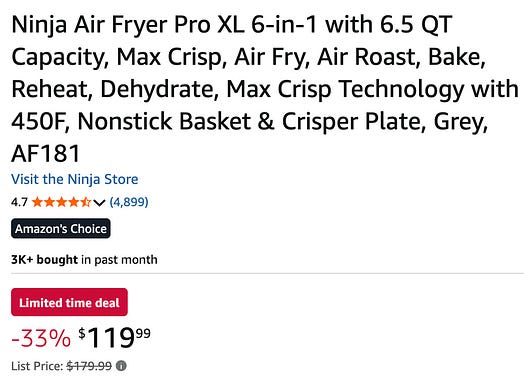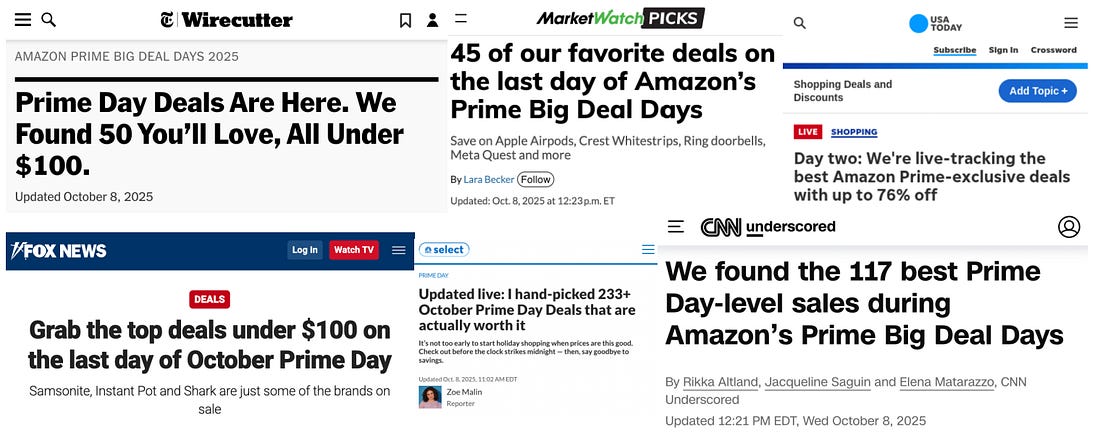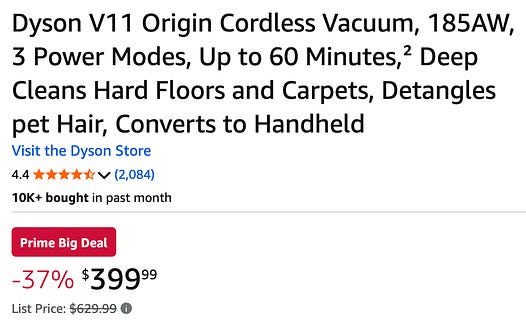|
 |
No billionaire overlords. No capitulation. No BS.
Upgrade to paid to support Popular Information’s independent accountability journalism.
UPDATE: Lawsuit alleges Prime Day is a fraud
The federal class action lawsuit has been ignored by major media outlets, which continue to promote Prime Day deals.
In July, Popular Information published an exposé about Amazon’s Prime Day, demonstrating how the retailer deploys deceptive tactics to exaggerate its markdowns and create a false sense of urgency. The piece demonstrated how many featured products are available at similar or lower prices at other times.
For example, on July 8, the Ninja Air Fryer Pro XL was on sale for $119.99, which Amazon said is a 33% discount off the list price of $179.99.
But the online tool Camel Camel Camel revealed that the air fryer had never been listed at $179.99 until just before Prime Day, and had been available for $119.99 or less every month since last November. The air fryer was available for $119.99 at Macy’s, Best Buy, Kohl’s, and Wayfair.
In late September, two customers filed a federal class-action lawsuit in Washington State against Amazon, citing the same practices reported in Popular Information. The complaint alleges that Amazon “is rife with fake sales and misleading ‘percent off’ claims.” The plaintiffs claim that many products featured on Prime Day “were never sold, for the last 90 days if not longer, at the stricken through Fake Prior Amazon Price.” According to the lawsuit, Amazon’s conduct amounts to “fraudulent advertising” and “violates Washington’s consumer protection laws, which prohibit ‘unfair methods of competition and unfair or deceptive acts or practices.’”
The filing of the class action lawsuit has received no coverage in the mainstream media. CNN, NBC News, the New York Times, Fox News, USA Today, and Marketwatch ignored the story. And yet, over the last few days, all of those outlets published one or more articles promoting Prime Day sales to their readers, this time as part of October’s Prime Deal Days.
The deals offered during this sale are similarly dubious. For example, a Dyson cordless vacuum is being advertised as 37% off its list price of $629.99. But the vacuum had never been sold on Amazon for $629.99 until September. It’s available on Amazon nearly every month for less than $500. Over the Christmas and New Year’s holidays last year, the same vacuum was available on Amazon for $349.99.
Although the actual savings to consumers may be minimal, Prime Days have proven extremely successful in generating billions of additional sales for Amazon. This creates pressure on Amazon’s labor force, which already works at a breakneck pace, to push even faster. A 2024 report by the Senate Health, Education, Labor, and Pension Committee found that 45% of Amazon warehouse employees were injured during a recent Prime Day.
When media outlets create lists of featured deals, they include links to the product on Amazon. If a reader clicks the link and makes a purchase, the media outlets receive a cut. This has become a big business. In 2024, Wirecutter, the New York Times’ shopping recommendation site, reportedly drove $1 billion in gross merchandise sales. In the second quarter of 2025, the New York Times reported $70.5 million in affiliate sales revenue, mainly from Wirecutter referrals to Amazon and other retailers.
While this arrangement is nearly ubiquitous, it may be incompatible with rigorous coverage of Amazon’s business practices.
Dark patterns
The Prime Day lawsuit was filed days before Amazon paid a $2.5 billion fine to the Federal Trade Commission to settle allegations that it tricked customers. The settlement resolved allegations “that Amazon enrolled millions of consumers in Prime subscriptions without their consent, and knowingly made it difficult for consumers to cancel.” These practices are known as “dark patterns.”
Specifically, the FTC alleged that “Amazon created confusing and deceptive user interfaces to lead consumers to enroll in Prime without their knowledge.” The FTC said it had obtained documents in preparation for a trial showing “Amazon executives and employees knowingly discussed these unlawful enrollment and cancellation issues.”
As part of the settlement, Amazon will also have to end certain practices. For example, it can no longer require consumers to click a button saying, “No, I don’t want free shipping,” to opt out of Prime enrollment. $1.5 billion of the settlement will go to consumers “impacted by unwanted Prime enrollment or deferred cancellation.”
Popular Information doesn’t just break news; it creates change. Consider a few examples of the impact of this newsletter this year:
On March 17, Popular Information exclusively published an internal Social Security Administration (SSA) memo that revealed plans to significantly limit phone service beginning April 1. The memo said the plan would flood already overburned field offices with millions of additional people, creating “service disruption,” “operational strain,” and “budget shortfalls.” Popular Information’s report was covered extensively in the national media and prompted protests from advocacy groups. On April 8, the SSA announced that it was canceling its plans to limit phone service.
On April 15, Popular Information reported that dozens of people had their ballots in the 2024 general election wrongly discarded by the North Carolina Supreme Court. The ballots were challenged by Jefferson Griffin, a Republican candidate for a seat on the North Carolina Supreme Court who lost a close election to Democrat Allison Riggs. On May 5, in a decision that referenced Popular Information’s reporting, a federal court declared Riggs the winner and Griffin conceded.
On August 4, Popular Information broke the news that President Trump’s Super PAC accepted a $5 million donation from Extremity Care, a company that sells expensive bandages made from dried placentas, days before the Trump administration delayed a rule that would have prevented Medicare from covering its products. Medicare is spending billions on Extremity Care products, which can cost more than $10,000 per square inch, even though much cheaper alternatives—unlike Extremity Care’s—are backed by scientific evidence. On August 11, the New York Times covered the scandal on its front page, crediting Popular Information’s reporting.


